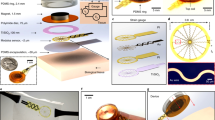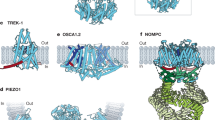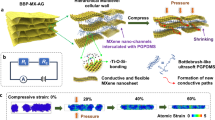Abstract
Small d.c. electrical signals have been detected in many biological systems and often serve important functions in cells and organs. For example, we have recently found that they play a far more important role in directing cell migration in wound healing than previously thought. Here, we describe the manufacture and use of a simplified ultrasensitive vibrating probe system for measuring extracellular electrical currents. This vibrating probe is an insulated, sharpened metal wire with a small platinum-black tip (10–30 μm), which can detect ionic currents in the μA cm−2 range in physiological saline. The probe is vibrated at about 300 Hz by a piezoelectric bender. In the presence of an ionic current, the probe detects a voltage difference between the extremes of its movement. The basic, low-cost system we describe is readily adaptable to most laboratories interested in measuring physiological electric currents associated with wounds, developing embryos and other biological systems.
This is a preview of subscription content, access via your institution
Access options
Subscribe to this journal
Receive 12 print issues and online access
$259.00 per year
only $21.58 per issue
Buy this article
- Purchase on Springer Link
- Instant access to full article PDF
Prices may be subject to local taxes which are calculated during checkout






Similar content being viewed by others
References
Barker, A.T., Jaffe, L.F. & Vanable, J.W., Jr. The glabrous epidermis of cavies contains a powerful battery. Am. J. Physiol. 242, R358–R366 (1982).
Hotary, K.B. & Robinson, K.R. Endogenous electrical currents and the resultant voltage gradients in the chick embryo. Dev. Biol. 140, 149–160 (1990).
Metcalf, M.E.M., Shi, R.Y. & Borgens, R.B. Endogenous ionic currents and voltages in amphibian embryos. J. Exp. Zool. 268, 307–322 (1994).
Nuccitelli, R. Transcellular ion currents: signals and effectors of cell polarity. Mod. Cell Biol. 2, 451–481 (1983).
Hagins, W.A., Penn, R.D. & Yoshikami, S. Dark currents and photocurrent in retinal rods. Biophys. J. 10, 380–412 (1970).
DuBois-Reymond, E. Vorläufiger Abriss einer Untersuchung uber den sogenannten Froschstrom und die electomotorischen Fische. Ann. Phy. U. Chem. 58, 1–30 (1843).
Piccolino, M. Luigi Galvani and animal electricity: two centuries after the foundation of electrophysiology. Brain Res. Bull. 46, 381–407 (1997).
Piccolino, M. The bicentennial of the Voltaic battery (1800–2000): the artificial electric organ. Trends Neurosci. 23, 147–151 (2000).
Borgens, R.B., Vanable, J.W., Jr. & Jaffe, L.F. Bioelectricity and regeneration. I. Initiation of frog limb regeneration by minute currents. J. Exp. Zool. 200, 403–416 (1977).
Borgens, R.B., Vanable, J.W., Jr. & Jaffe, L.F. Bioelectricity and regeneration: large currents leave the stumps of regenerating newt limbs. Proc. Natl. Acad. Sci. USA 74, 4528–4532 (1977).
Borgens, R.B., Vanable, J.W., Jr. & Jaffe, L.F. Role of subdermal current shunts in the failure of frogs to regenerate. J. Exp. Zool. 209, 49–56 (1979).
Illingworth, C.M. & Barker, A.T. Measurement of electrical currents emerging during the regeneration of amputated fingertips in children. Clin. Phys. Physiol. Meas. 1, 87–89 (1980).
Chiang, M., Robinson, K.R. & Vanable, J.W., Jr. Electrical fields in the vicinity of epithelial wounds in the isolated bovine eye. Exp. Eye Res. 54, 999–1003 (1992).
Reid, B., Song, B., McCaig, C.D. & Zhao, M. Wound healing in rat cornea: the role of electric currents. FASEB J. 19, 379–386 (2005).
Wang, E., Reid, B., Lois, N., Forrester, J.V., McCaig, C.D. & Zhao, M. Electrical inhibition of lens epithelial cell proliferation: an additional factor in secondary cataract? FASEB J. 19, 842–844 (2005).
Robinson, K.R. & Messerli, M.A. Left/right, up/down: the role of endogenous electrical fields as directional signals in development, repair and invasion. BioEssays 25, 759–766 (2003).
Borgens, R.B. Endogenous ionic currents traverse intact and damaged bone. Science 225, 478–482 (1984).
Borgens, R.B., Jaffe, L.F. & Cohen, M.J. Large and persistent electrical currents enter the transected lamprey spinal cord. Proc. Natl. Acad. Sci. USA 77, 1209–1213 (1980).
Gow, N.A. & McGillivray, A.M. Ion currents, electrical fields and the polarized growth of fungal hyphae. in Ionic Currents in Development (ed. Nuccitelli, R.) 81–88 (Alan R. Liss, New York, 1986).
Gow, N.A. Circulating ionic currents in micro-organisms. Adv. Microb. Physiol. 30, 89–123 (1989).
Weisenseel, M.H. & Meyer, A.J. Bioelectricity, gravity and plants. Planta 203 (suppl. 1): S98–S106 (1997).
van West, P. et al. Oomycete plant pathogens use electric fields to target roots. Mol. Plant Microbe Interact. 15, 790–798 (2002).
Borgens, R.B., Roederer, E. & Cohen, M.J. Enhanced spinal cord regeneration in lamprey by applied electric fields. Science 213, 611–617 (1981).
Borgens, R.B., Blight, A.R. & McGinnis, M.E. Behavioral recovery induced by applied electric fields after spinal cord hemisection in guinea pig. Science 238, 366–369 (1987).
Borgens, R.B. Are limb development and limb regeneration both initiated by an integumentary wounding? A hypothesis. Differentiation 28, 87–93 (1984).
Jaffe, L.F. & Vanable, J.W., Jr. Electric fields and wound healing. Clin. Dermatol. 2, 34–44 (1984).
Lee, R.C., Canaday, D.J. & Doong, H. A review of the biophysical basis for the clinical application of electric fields in soft-tissue repair. J. Burn Care Rehabil. 14, 319–335 (1993).
McCaig, C.D. & Zhao, M. Physiological electrical fields modify cell behaviour. BioEssays 19, 819–826 (1997).
Altizer, A.M., Moriarty, L.J., Bell, S.M., Schreiner, C.M., Scott, W.J. & Borgens, R.B. Endogenous electric current is associated with normal development of the vertebrate limb. Dev. Dyn. 221, 391–401 (2001).
Ojingwa, J.C. & Isseroff, R.R. Electrical stimulation of wound healing. J. Invest. Dermatol. 121, 1–12 (2003).
Nuccitelli, R. Endogenous electric fields in embryos during development, regeneration and wound healing. Radiat. Prot. Dosimetry 106, 375–383 (2003).
Nuccitelli, R. A role for endogenous electric fields in wound healing. Curr. Top. Dev. Biol. 58, 1–26 (2003).
McCaig, C.D., Rajnicek, A.M., Song, B. & Zhao, M. Controlling cell behaviour electrically: current views and future potential. Physiol. Rev. 85, 943–978 (2005).
Shi, R. & Borgens, R.B. Embryonic neuroepithelial sodium transport, the resulting physiological potential, and cranial development. Dev. Biol. 165, 105–116 (1994).
Shi, R. & Borgens, R.B. Three-dimensional gradients of voltage during development of the nervous system as invisible coordinates for the establishment of embryonic pattern. Dev. Dyn. 202, 101–114 (1995).
Hotary, K.B. & Robinson, K.R. Endogenous electrical currents and the resultant voltage gradients in the chick embryo. Dev. Biol. 140, 149–160 (1990).
Hotary, K.B. & Robinson, K.R. Endogenous electrical currents and voltage gradients in Xenopus embryos and the consequences of their disruption. Dev. Biol. 166, 789–800 (1994).
Levin, M. Bioelectromagnetics in morphogenesis. Bioelectromagnetics 24, 295–315 (2003).
Levin, M. The embryonic origins of left–right asymmetry. Crit. Rev. Oral Biol. Med. 15, 197–206 (2004).
Jaffe, L.F. & Stern, C.D. Strong electrical currents leave the primitive streak of chick embryos. Science 206, 569–571 (1979).
Zhao, M. et al. Electrical signals control wound healing through phosphatidylinositol-3-OH kinase-γ and PTEN. Nature 442, 457–460 (2006).
Jaffe, L.F. & Nuccitelli, R. An ultrasensitive vibrating probe for measuring steady extracellular currents. J. Cell Biol. 63 (2 Part 1): 614–628 (1974).
Freeman, J.A. et al. Steady growth cone currents revealed by a novel circularly vibrating probe: a possible mechanism underlying neurite growth. J. Neurosci. Res. 13, 257–284 (1985).
Scheffey, C. Two approaches to construction of vibrating probes for electrical current measurement in solution. Rev. Sci. Instr. 59, 787–792 (1988).
Scheffey, C. Pitfalls of the vibrating probe technique, and what to do about them. in Ionic Currents in Development (ed. Nuccitelli, R.) 3–12 (Alan R. Liss, New York, 1986.
Scheffey, C. Electric fields and the vibrating probe, for the uninitiated. in Ionic Currents in Development (ed. Nuccitelli, R.) xxv–xxxvii (Alan R. Liss, New York, 1986).
Robinson, K.R. Endogenous and applied electrical currents: their measurement and application. in Electric Fields in Vertebrate Repair (eds. Borgens, R.B., Robinson, K.R., Vanable, J.W., McGinnis, M.E., McCaig, C.D.) 1–25 (Alan R. Liss Inc., New York, 1989).
Freeman, J.A., Manis, P.B., Samson, P.C. & Wikswo, J.P., Jr. Microprocessor controlled two- and three-dimensional vibrating probes with video graphics: Biological and electro-chemical applications. in Ionic Currents in Development (ed. Nuccitelli, R.) 21–36 (Alan R. Liss, New York, 1986).
Hotary, K.B., Nuccitelli, R. & Robinson, K.R. A computerized 2-dimensional vibrating probe for mapping extracellular current patterns. J. Neurosci. Methods 43, 55–67 (1992).
Smith, P.J.S.S., Sanger,, R.H. & Jaffe, L.F. The vibrating Ca2+ electrode: a new technique for detecting plasma membrane regions of Ca2+ influx and efflux. Methods Cell Biol. 40, 115–134 (1994).
Smith, P.J.S.S., Hammar, K., Porterfield, D.M., Sanger, R.H. & Trimarchi, J.R. Self-referencing, non-invasive, ion selective electrode for single cell detection of trans-plasma membrane calcium flux. Microsc. Res. Tech. 46, 398–417 (1999).
Marenzana, M., Shipley, A.M., Squitiero, P., Kunkel, J.B. & Ribinacci, A. Bone as an ion exchange organ: evidence for instantaneous cell-dependent calcium efflux from bone not due to resorption. Bone 37, 545–554 (2005).
Kunkel, J.G., Cordeiro, S., Xu, Y., Shipley, A.M. & Feijo, J.A. The use of non-invasive ion-selective microelectrode techniques for the study of plant development. in Plant Electrophysiology—Theory and Methods (ed. Volkov, A.G.) 109–137 (Springer-Verlag, Berlin/Heidelberg, 2006).
Messerli, M.A., Robinson, K.R. & Smith, P.J.S.S. Electrochemical sensor applications to the study of molecular physiology and analyte flux in plants. in Plant Electrophysiology—Theory and Methods (ed. Volkov, A.G.) Ch. 4, 73–107 (Springer-Verlag, Berlin/Heidelberg, 2006).
Smith, P.J.S.S., Sanger,, R.S. & Messerli, M.A. Principles, development and applications of self-referencing electrochemical microelectrodes to the determination of fluxes at cell membranes. in Methods and New Frontiers in Neuroscience (ed. Michael, A.C.) Ch. 18, 373–405 (CRC Press, Boca Raton, Florida, USA 2007).
Nuccitelli, R. Vibrating probe technique for studies of ion transport. in Noninvasive Techniques in Cell Biology Ch. 11, 273–310 (Wiley-Liss Inc., Boca Raton, Florida, USA 1990).
Nawata, T. A simple method for making a vibrating probe system. Plant Cell Physiol. 25, 1089–1094 (1984).
Dorn, A. & Weisenseel, M.H. Advances in vibrating probe techniques. Protoplasma 113, 89–96 (1982).
Acknowledgements
We thank Neil Gow for allowing us to re-assemble his vibrating probe system, Ann Rajnicek for technical advice and help with Figure 6c,d and Guy Bewick for photographic assistance. Bing Song contributed to Figures 4a–c and 5e, Christine Pullar to Figure 3e, Yao Li to Figure 6a and Noemi Lois to Figure 6b. We thank the Wellcome Trust for continuous support (058551, 068012). We are grateful to Ken Robinson, Alan Shipley and Peter Smith for many helpful comments on the manuscript. RN is a member of the BioCurrents Research Center Physiology of Development and Polarity Module (NIH:NCRR P41RR01395) and is also supported by NIH R44 GM069194. We thank expert referees and editors for comments and suggestions that greatly improved the manuscript.
Author information
Authors and Affiliations
Corresponding author
Ethics declarations
Competing interests
The authors declare no competing financial interests.
Rights and permissions
About this article
Cite this article
Reid, B., Nuccitelli, R. & Zhao, M. Non-invasive measurement of bioelectric currents with a vibrating probe. Nat Protoc 2, 661–669 (2007). https://doi.org/10.1038/nprot.2007.91
Published:
Issue Date:
DOI: https://doi.org/10.1038/nprot.2007.91
This article is cited by
-
Transepithelial potential difference governs epithelial homeostasis by electromechanics
Nature Physics (2022)
-
Electric Fields at Breast Cancer and Cancer Cell Collective Galvanotaxis
Scientific Reports (2020)
-
Real-time physiological measurements of oxygen using a non-invasive self-referencing optical fiber microsensor
Nature Protocols (2020)
-
Electrically stimulated cell migration and its contribution to wound healing
Burns & Trauma (2018)
-
Calcium oscillations coordinate feather mesenchymal cell movement by SHH dependent modulation of gap junction networks
Nature Communications (2018)
Comments
By submitting a comment you agree to abide by our Terms and Community Guidelines. If you find something abusive or that does not comply with our terms or guidelines please flag it as inappropriate.



